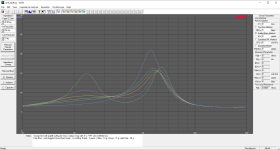Enclosure size or volume isn't a concern so just considering overall performance............sealed F3 is too high at 120hz for this application but i can get it to 80hz by porting it and power handling in this application isn't a problem......they'll be 32 of em per channel.
QTS @ .56 ( vs .39 ) would suggest a fairly large enclosure, BUT we need to know Fs & VAS ???
PLEASE EXPLAIN MORE ABOUT "32 per channel".
PLEASE EXPLAIN MORE ABOUT "32 per channel".
Last edited:
I have used woofers with Qts>0.55 in a vented box. Sometimes it works, but sometimes it doesn't sound quite right. If you want better sound quality, a resistive vent might be a reasonable solution.
I recently used a 10" woofer with a high Qts (>0.70 !!) in a box with a resistive vent. (The vent was rear-mounted to separate its output from the front-firing woofer.)
Dacron pillow/quilt stuffing from the fabric store was used. A little experimentation was needed to tune it. You can use the "click test". The attached picture shows a sealed box that can be stuffed, but the same idea can be applied to a resistive vent.
Or if you have a way to measure impedance (WT3 or DATS e.g.), add stuffing until the lower peak is more or less flattened. If you add more than enough, the stuffing tends to attenuate the bass output. I used velcro inside the vent tube to keep the stuffing from migrating or falling out.
For my example, I used the yellow curve in the attached "vent_stuff.png" pic. It tightened the bass pretty well.
I recently used a 10" woofer with a high Qts (>0.70 !!) in a box with a resistive vent. (The vent was rear-mounted to separate its output from the front-firing woofer.)
Dacron pillow/quilt stuffing from the fabric store was used. A little experimentation was needed to tune it. You can use the "click test". The attached picture shows a sealed box that can be stuffed, but the same idea can be applied to a resistive vent.
Or if you have a way to measure impedance (WT3 or DATS e.g.), add stuffing until the lower peak is more or less flattened. If you add more than enough, the stuffing tends to attenuate the bass output. I used velcro inside the vent tube to keep the stuffing from migrating or falling out.
For my example, I used the yellow curve in the attached "vent_stuff.png" pic. It tightened the bass pretty well.
Attachments
Last edited:
Of course! Keele's EBS alignment*, though it really boils down to 'does it meet the needs of the app, i.e. I've ported up to a (now ancient) near 3.0 QT RS 8" 'FR' driver.
EBS (X-bass) I got from Altec
*[Thiele #9.5]: Vb = 2.6*Vas, Fb = 0.52*Fs, 0.625 Qts'
EBS (X-bass) I got from Altec
*[Thiele #9.5]: Vb = 2.6*Vas, Fb = 0.52*Fs, 0.625 Qts'
In my 222L bookshelf speakers, I use a 7" mid-bass speaker which has a QTS=0.44 with a FS=38Hz and VAS=37L, for FC3=45Hz
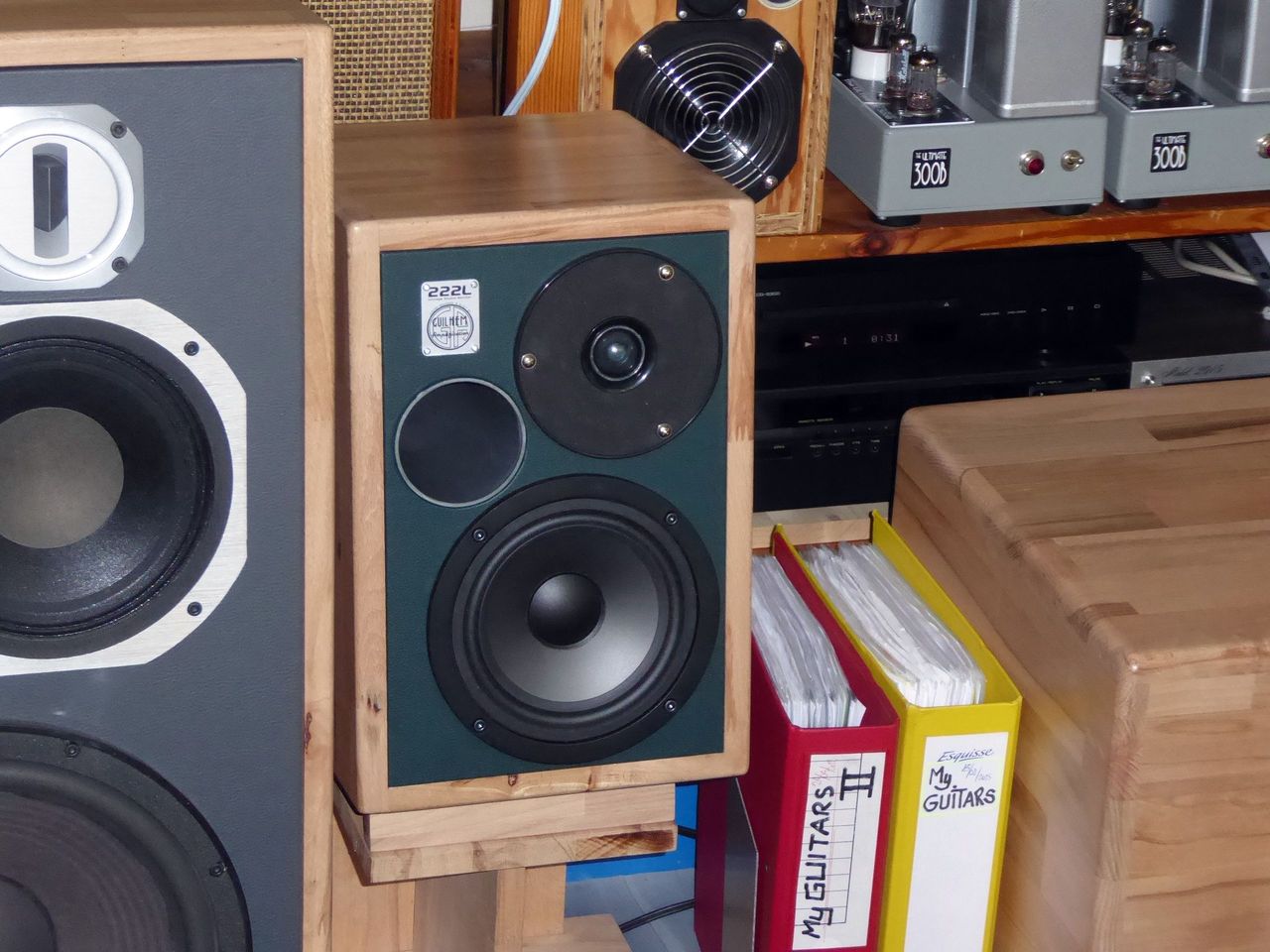
In my 345L project, I used a 12" woofer which has a QTS=0.5 with a FS=27Hz and VAS=142L, for FC3=40Hz
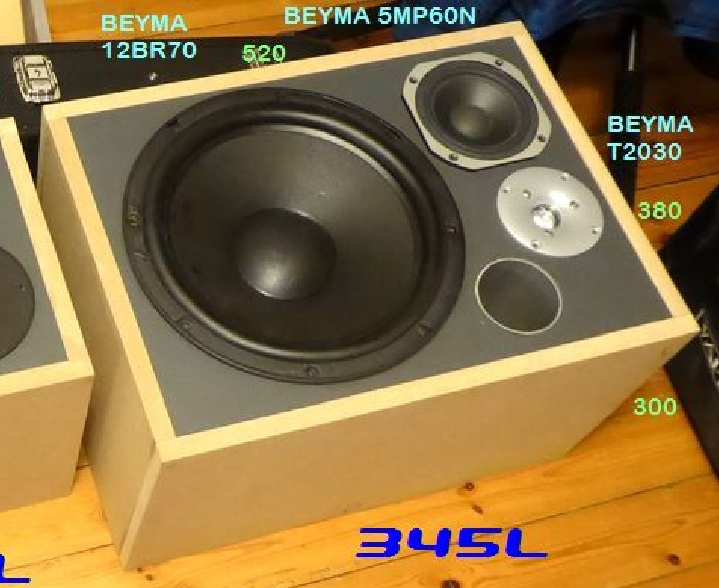
But 0.56 is even higher, and... 32 speakers ! 😱
T

In my 345L project, I used a 12" woofer which has a QTS=0.5 with a FS=27Hz and VAS=142L, for FC3=40Hz

But 0.56 is even higher, and... 32 speakers ! 😱
T
a line array arrangement with an horizontal MTM configuration with 32 M's .......two columns of 16 flanking a line of planar tweetersQTS @ .56 ( vs .39 ) would suggest a fairly large enclosure, BUT we need to know Fs & VAS ???
PLEASE EXPLAIN MORE ABOUT "32 per channel".
As far as I know the "problem" with high Qts woofers in ported enclosures is that the resonator peak is narrow, steep and quite high. the total response is never going to be exactly as simulated because of simulation model inaccuracies, varying TSP due to drive level variation, temperature variation, suspension ageing, tolerances of driver, port, enclosure etc.
Also the lower rolloff will be steep, leading to higher group delay.
But I guess you could try it and eventually adjust the tuning by adjusting port length or enclosure filling.
Also the lower rolloff will be steep, leading to higher group delay.
But I guess you could try it and eventually adjust the tuning by adjusting port length or enclosure filling.
You are more likely to have problems with column effects than porting the speakers. Go for it. You can always put a bung in the port.
I would also typically try a aperiodic or resistive vent cabinet, not a normal ported as it's bass response will be peaky (a one not bass) in many cases. And the cabinet needed will be big. If the driver have enough xmax, go sealed and use eq. It will be easier and smaller to do (certainly in a array)
Exactly the other way around. You described a low Qts woofer in a ported enclosure, not a relative high 0.56 one.As far as I know the "problem" with high Qts woofers in ported enclosures is that the resonator peak is narrow, steep and quite high. the total response is never going to be exactly as simulated because of simulation model inaccuracies, varying TSP due to drive level variation, temperature variation, suspension ageing, tolerances of driver, port, enclosure etc.
Also the lower rolloff will be steep, leading to higher group delay.
No, a low qts woofer will not excite the helmholtz resonance as much due to more electrical dampening. I'll provide an example, give me some time.Exactly the other way around.
The other way around. If everything else is the same (other T/S parameters, box size etc.), a lower Qts results a higher group delay peak, higher Q at Fb and steeper roll-off below Fb. Here is an example of BL=26 (Qts=0.18) vs BL=16 (Qts 0.45):No, a low qts woofer will not excite the helmholtz resonance

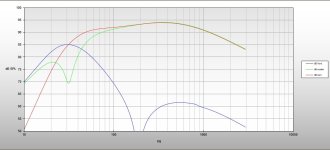
You said: "high Qts woofers in ported enclosures is that the resonator peak is narrow, steep and quite high". As we can see, exactly the opposite.
Last edited:
Well, you are right and I should have been more precise:As we can see, exactly the opposite.
"problem with high Qts woofers in ported enclosures is that the resonator peak is narrow, steep and quite high for a useful tuning".
The low qts tuning you show is not very usable without equalising and you are absolutely right, for this case.
However, if you compare max-flat tunings for different Qts woofers you get this:
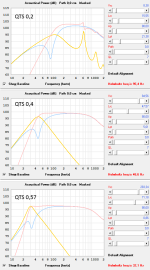
I only varied Qes, for simplicity.
So I guess we are both right and there is not one simple answer!
But we can't compare it this way IMO because the high Fb + small box limits the low-end extension. So you may have lower port Q in a smaller enclosure with the lower Qts woofer but the usable low-frequency extension is far worse than with the higher Qts + large box + lower Fb. Despite the higher group delay, I would choose the latter (high Qts + large box) for home/hifi application at any day (if xmax of the woofer is enough for the desired max SPL).However, if you compare max-flat tunings for different Qts woofers you get this:
Last edited:
Well, you are right again: we cannot compare different Qts woofers, because they are different!But we can't compare it this way IMO because the high Fb + small box limits the low-end extension
Also in your simulation the f3 points are very different: for the low qts woofer it's around 180 Hz and for the high qts woofer it's about 55 Hz.
I agree!I would choose the latter for home/hifi application at any day
But this speaker will also be more susceptible to tuning variations or inaccuracies and have higher group delay at lower end.
And it's huge!
Just use a smaller box and/or use the right EQ settings and the high group delay are gone if it's a problem otherwise.have higher group delay at lower end.
And it's huge!
Another possible way is to tune the ported enclosure quite low, in order to report the group delay issues in the infra-bass : it sometimes works with some high QTS speakers... But again, it completely depends on the characteristics of the speaker itself, I mean : the sole QTS value is not enough.
T
T
- Home
- Loudspeakers
- Multi-Way
- Would you use a .56 Qts driver in a ported alignment?

